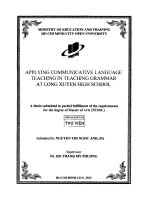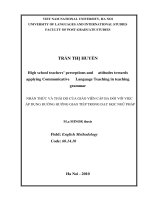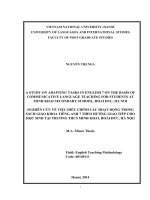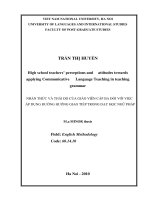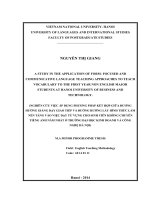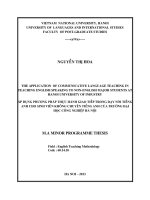Communicative language teaching in practice a study of four post graduate student teachers in thailand
Bạn đang xem bản rút gọn của tài liệu. Xem và tải ngay bản đầy đủ của tài liệu tại đây (2.19 MB, 550 trang )
COMMUNICATIVE LANGUAGE TEACHING IN PRACTICE?:
A STUDY OF FOUR POST-GRADUATE STUDENT TEACHERS
IN THAILAND
AURAPAN WEERAWONG
(BEd English, Srinakharinwirot University
MA TESOL, University of London)
A THESIS SUBMITTED FOR THE DEGREE OF
DOCTOR OF PHILOSOPHY
DEPARTMENT OF ENGLISH LANGUAGE AND LITERATURE
NATIONAL UNIVERSITY OF SINGAPORE
2004
i
ACKNOWLEGEMENTS
Without patient encouragement and support from many people, this thesis would not
have been realized. First of all, I would like to gratefully acknowledge the enthusiastic
supervision of Associate Professor Dr. Christopher J. Stroud during this work. I am
also deeply indebted to two former supervisors. They are Associate Professor Dr.
Joseph A. Foley, former Deputy Head of the Department of English Language and
Literature, who provided constructive comments at various stages of the thesis. I
deeply value his encouragement and sincere support. I would like to extend my
gratitude to Professor Dr. Linda Thompson, who is currently the Director of Research
and Teaching Group, University of Manchester. She offered much support and
valuable discussions during the preliminary version of this thesis.
I would also like to extend my sincere gratitude to a number of people at the National
University of Singapore, namely Assistant Professor, Dr. Titima Suthiwan, the
convenor of Thai language of Centre for Language Studies, whose encouragement
helped me in times of difficulties; Dr. Ruanni F. Tupas, Centre for English Language
Communication, for his stimulating suggestions and proof reading, Nicole Lasas and
Regent Lamoureux for their help in proof reading within unreasonable time. My
special thanks go to Ms. Sasiwimol Klayklueng and Gracie Lim Yi Ling, the
coordinator and the secretary of Thai language programme of Centre for Language
Studies, for their sympathetic ears and their great helps in difficult moments.
I am also thankful to the four informants, for their participation in this study. With
their permission, I am granted the opportunities for the classroom observation and
ii
interview. These are crucial to my research. I am highly indebted to my colleagues’
support and Srinakharinwirot University for the grant that allowed me to pursue my
study at the National University of Singapore.
My most heartfelt acknowledgments must go to my father and mother, who may
never read my thesis, my brothers, and sister Took, for always being there when I
needed their love and support.
I wish to convey my special gratitude to the thesis committee, Associate Professor Dr.
Robbie Goh, Head of Department of English Language and Literature, Assistant
Professor Dr. Michelle M. Lazar, Dr Rubdy Rani Sumant, and Associate Professor
Dr. Bao Zhiming, for their most helpful comments and advice. I also wish to thank
Associate Professor Dr. John A. Richardson, for his help, support, interest and
valuable advice on various issues of my study. Lastly, I owe a huge debt of gratitude
to the National University of Singapore for the scholarship and research grant.
iii
TABLE OF CONTENTS
ACKNOWLEDGEMENTS i i
TABLE OF CONTENTS iv iv
LIST OF TABLES x
LIST OF FIGURES xi
SUMMARY xiii
ABBREVIATION xvi
iv
TABLE OF CONTENTS
CHAPTER 1 INTRODUCTION
1.1 Background 1
1.2 Research questions 8
1.3 Methodology 8
CHAPER 2 ENGLISH LANGUAGE TEACHING IN THAILAND:
A BACKGROUND
2.1 Introduction 11
2.2 Background of English education in Thailand 11
2.3 English curricula, teacher education, and teaching methodologies 14
2.4 Education reform 1996-2007: Basic education curriculum 19
2.5 The teaching of English as a foreign language in Thailand 20
2.6 The status of communicative language teaching 21
2.7 Major issues 22
2.8 Issues in EFL education 28
2.9 Conclusion 31
CHAPTER 3 SITUATING THE STUDY: LANGUAGE LEARNING
3.1 Introduction 32
3.2 Notions of ESL, EFL, and SLA 32
3.3 Second language acquisition and L2 learning 34
3.4 Classroom discourse studies 40
3.5 EFL education: conceptual development 47
3.6 Debates on pedagogical appropriateness 48
v
3.7 Conclusion 52
CHAPER 4 COMMUNICATIVE LANGUAGE TEACHING
4.1 Introduction 53
4.2 Communicative language teaching 53
4.3 Implementing principles of CLT in Thai teacher training 63
4.4 Conclusion 72
CHAPTER 5 THE ANALYTICAL FRAMEWORK AND RESEARCH
METHODOLOGY
5.1 Introduction 73
5.2 Analytical framework 73
5.3 Data collection instruments 82
5.4 Methodology 92
5.5 Data analysis 104
5.6 Conclusion 106 106
CHAPTER 6 PROBLEMS IN CLT IN PRACTICE: QUALITATIVE
ANALYSIS 1
6.1 Introduction 108
6.2 Student Teacher 2: T2-ST 109
6.3 Analysis of classroom practice of Student Teacher 2 (T2-ST) 110
6.4 Summary: A checklist of the teaching procedures, classroom management 130
practices, and classroom resources of Student Teacher 2 (T2-ST)
6.5 Conclusion to Student Teacher 2 (T2-ST) 132
6.6 Student Teacher 3: T3-ST 132
6.7 Analysis of classroom practice of Student Teacher 3 (T3-ST) 134
vi
6.8 Summary: Checklist of the teaching procedures, classroom management 155
practices, and classroom resources of Student Teacher 3(T3-ST)
6.9 Conclusion to Student Teacher3 (T3-ST) 156
6.10 Student Teacher 4:T4-ST 157
6.11 Analysis of classroom practice of Student Teacher 4 (T4-ST) 158
6.12 Summary: Checklist of the teaching procedures, classroom management 176
practices, and classroom resources of Student Teacher 4 (T4-ST)
6.13 Conclusion to Student Teacher 4 (T4-ST) 178
6.14 General summary: Checklist of teaching procedure, classroom 178
management practices, and classroom resources of all four teacher students
6.15 General conclusion 181
CHAPTER 7 PROBLEMS IN CLT PRACTICE IN THE OTHER THREE
LESSONS RELATING OTHER SKILLS: QUALITAT IVE
ANALYSIS 2
7.1 Introduction 183
7.2 Student Teacher 2: T2-SPK 184
7.3 Analysis of classroom practice of Student Teacher 2 (T2-SPK) 184
7.4 Conclusion to Student Teacher 2 (T2-SPK) 192
7. 5 Student Teacher 3: T3-RD 193
7.6 Analysis of classroom practice of Student Teacher 3 (T3-RD) 194
7.7 Conclusion to Teacher Student 3 (T3-RD) 201
7.8 Student Teacher 4: T4-LST 201
7.9 Analysis of classroom practice of Student Teacher 4: T4-LST 202
7.10 Conclusion to Student Teacher 4 (T4-LST) 213
7.11 General summary: Checklist of the teaching procedures, classroom 213
management, and classroom resources of all four teacher students
7.12 General conclusion 216
vii
CHAPTER 8 POSSIBILITIES FOR CLT IN PRACTICE IN STRUCTURAL
LESSON: QUALITATIVE ANALYSIS 3
8.1 Introduction 217
8.2 Student Teacher 1: T1-ST 218
8.3 Analysis of classroom practice of Student Teacher1 (T1-ST) 219
8.4 Summary: Checklist of the teaching procedures, classroom 248
management practices, and classroom resources
8.5 Conclusion to Student Teacher 1 (T1-ST) 250
CHAPTER 9 POSSIBILITIES IN CLT PRACTICE IN THE LESSON
RELATING OTHER SKILLS: QUALITATIVE ANALYSIS 4
9.1 Introduction 252
9.2 Student Teacher 1: T1-RD 252
9.3 Analysis of classroom practice of Student Teacher1 (T1-RD) 253
9.4 Summary: Checklist of the teaching procedures, classroom 268
management practices, and classroom resources of
Teacher Student 1 (T1-RD)
9.5 Conclusion to Student Techer1 (T1-RD) 269
9.6 Evidence of changes in all four informants’ teaching behaviours 270
9.7 General conclusion 273
viii
CHAPTER 10 POSSIBILITIES AND PROBLEMS IN CLT IN PRACTICE:
QUANTITATIVE ANALYSIS 5
10.1 Introduction 274
10.2 Analysis of the overall classroom interaction 274
10.3 Findings and discussion 275
10.4 Analysis of classroom interaction 281
10.5 Conclusion 316
CHAPTER 11 SOCIO-CULTURAL DIMENSIONS IN CLASSROOM
INTERACTION: QUALITATIVE ANALYSIS 6
11.1 Introduction 319
11.2 Some conceptual considerations 320
11.3 Classroom interaction analysis: Findings and discussion 326
Part I: Inadaptability to CLT practice: T2, T3, AND T4
11.4 Conclusion to inadaptability to CLT practice 347
Part II: Possibilities of CLT practice: T1
11.5 Findings and discussion 348
11.6 Conclusion 359
11.7 General conclusion 359
CHAPTER 12 DISCUSSION AND CONCLUSION
12.1 Introduction 362
12.2 The research findings 362
12.3 Implications of the study 372
12.4 Limitations of study 392
ix
12.5 Recommendations for further study 393
Bibliography 396
Appendices 418
x
LIST OF TABLES
Page
Table 2.1 Fundamental English 16
Table 2.2 English for English Concentration 17
Table 2.3 English for business 17
Table 5.1 The Interaction Analysis Categories 87
Table 5.2 The four informants’ profiles 93
Table 5.3 The schools’ profiles 94
Table 5.4 The transcripts of lessons 99
Table 5.5 Data analysis 106
Table 10.1 Overall mean and standard deviation scores on all lessons 278
Table 10.2a Overall percentages of teacher’s explanations in structural lessons 292
Table 10.2b Overall percentages of teacher’s explanations in lessons relating to 293
the other skills
Table 10.3a Overall percentages of teacher’s questions, explanation, and 302
evaluation in structural lessons
Table 10.3b Overall percentages of teacher’s questions, explanation, and 302
evaluation in lessons relating to the other skills
xi
LIST OF FIGURES
Page
Fig. 4.1 Teaching Methodology Cline 67
Fig. 5.1 Johnson’s (1995) framework for understanding communication 79
in second language classroom
Fig. 5.2 Analytical framework 81
Fig. 10a Distributions of the classroom interaction in structural lessons 276
Fig. 10b Distributions of classroom interaction in the lessons relating the 277
other skills
Fig 10.1a Display questions made by teachers in structural lessons 282
Fig 10.1b Display questions made by teachers in the lessons relating 282
the other skills
Fig 10.2a Referential questions made by teachers in structural lessons 283
Fig 10.2b Referential questions made by teachers in the lessons relating 283
the other skills
Fig. 10.3a Explaining grammar in structural lessons 288
Fig. 10.3b Explaining grammar in the lessons relating the other skills 288
Fig. 10.4a Explaining vocabulary in structural lessons 290
Fig. 10.4b Explaining vocabulary in the lessons relating the other skills 290
Fig. 10.5a Explaining content in structural lessons 292
Fig. 10.5b Explaining content in the lessons relating the other skills 292
Fig. 10.6a Modification by teachers in structural class 294
Fig. 10.6b Modification by teachers in the lessons relating the other skills 294
Fig. 10.7a Instruction by teachers in structural lessons 295
Fig. 10.7b Instruction by teachers in the lessons relating the other skills 295
Fig. 10.8a Checking understanding after giving instruction in structural lessons 297
Fig. 10.8b Checking understanding after giving instruction in the lessons 297
relating the other skills
xii
Fig. 10.9a Praising students’ performance in structural lessons 299
Fig. 10.9b Praising students’ performance in the lessons relating the other 299
skills
Fig. 10.10a Teacher evaluates student’s responses in structural lessons 300
Fig. 10.10b Teacher evaluates student’s responses in the lessons 300
relating the other skills
Fig. 10.11a Negotiating with students in structural lessons 304
Fig. 10.11b Negotiating with students in the lessons relating the other skills 304
Fig. 10.12aa Minimal responses by students in structural lessons 306
Fig. 10.12ab Minimal responses by students in the lessons relating 306
the other skills
Fig. 10.12ba Responses in complete idea by students in structural class 306
Fig. 10.12bb Responses in complete idea by students in the lessons relating 306
the other skills
Fig. 10.13a Learners’ initiation made to the teacher in structural lessons 306
Fig. 10.13b Learners’ initiation made to the teacher in the lessons relating 308
the other skills
Fig. 10.14a Repetition and drills made by students in structural lessons 308
Fig. 10.14b Repetition and drills made by students in the lessons relating 310
the other skills
Fig. 10.15a Learners’ initiation made to another learner in structural lessons 312
Fig. 10.15b Learners’ initiation made to another learner in the lessons relating 312
The other skills
Fig. 10.16a Period f silence in structural lessons 314
Fig. 10.16b Period f silence in the lessons relating the other skills 314
xiii
SUMMARY
This study is an exploration of the actual practices, the consequences of teaching and
learning behaviours, and the implementation of Communicative Language Teaching
(CLT) in schools in Thailand. It investigates if teachers undergo re- training
programme in CLT show evidence of implementing CLT pedagogy within their
classrooms, and what contribute to successful or not successful practices.
Chapter 1 addresses the teaching of English as a foreign language (EFL) in Thai
schools, failures of EFL, CLT training and practices, and the research questions for
this study.
Chapter 2 provides the background for the needs of English, its roles in society and
among Thai students, and EFL in Thailand. It describes the introduction of CLT to
Thai schools, and major issues in ELT in Thailand are addressed.
Chapter 3 situates this study by reviewing the second language teaching and learning
and related literature on classroom discourse, teacher talk, learner’s participation, EFL
education and debates on pedagogical appropriateness of the culture specific to
innovative methodology.
Chapter 4 reviews the theoretical assumptions and principles of CLT, which aims to
make communicative competence as the goal of language teaching. The presentation-
practice-and production (P-P-P) procedures of teaching for the study are described.
xiv
Chapter 5 describes the analytical framework and the research methodology, which is
a combination of qualitative and quantitative analysis. A classroom observation is
adopted for a description and interpretative-explanatory account of teaching and
learning behaviours. It is conducted through Johnson’s (1995) framework for
understanding for communication in second language classroom and pedagogical
paradigm for the CLT attempts. An interaction analysis category (IAC) adapted from
Nunan (1990) is developed and employed for a quantitative analysis.
Chapter 6 to Chapter 9 are dedicated to qualitative analysis, which interpretative
framework is applied to the analysis of the four informants in all eight lessons.
Transcripts of classroom interaction, incorporated some other research techniques, are
analysed and discussed for teaching and learning behaviours, which contribute to or
constrain CLT. The problems in CLT practice as found in the lessons of T2, T3 and
T4 are presented and analysed in Chapter 6 concerning structural lessons (Analysis 1),
and in Chapter 7 concerning lessons relating other skills (Analysis 2). The potential
presence of CLT practice as found in informant T1’s teaching is presented and
analysed in Chapter 8 concerning her structural lesson (Analysis 3), and in Chapter 9
for the remaining lesson associated to other skills (Analysis 4).
In Chapter 10, an interaction analysis category is applied to capture and quantify the
teacher and learner behaviours in all lessons. The findings are the supplements to the
interpretative analyses.
xv
In Chapter 11, an interpretative approach is applied within the socio-cultural
framework, to analyse the teachers and learners’ behaviours as influenced by the
social norms and homogeneous culture. Conclusions are drawn from the language
used and strategies employed by the participants for appropriateness or
inappropriateness to CLT implementation.
The final chapter, Chapter 12, presents the researcher’s discussion and conclusion of
this study. It provides the research findings, which are problems in implementing
CLT, affected by the social contexts and different interpretations and practices of the
individuals, and the possibilities for CLT in practice to emerge. The implications of
this study are also proposed.
xvi
ABBREVIATIONS
Abbreviations used in this study are as follow.
CLT Communicative Language Teaching
ELT English Language Teaching
ESL English as a Second Language
EFL English as a Foreign Language
TEFL Teaching English as a Foreign Language
FL Foreign language
SL Second language
SLA Second language acquisition
L1 first language or the mother tongue
L2 the second language or the target language
MOE Ministry of Education
MUA Ministry University Affairs
DCID Department of Curriculum and Instruction Development
1
Chapter 1
Introduction
1.1 Background
The English language was brought to Thailand by missionaries and traders from
Western countries in the mid 1800s. During this period of political pressure from the
West, Thailand had to introduce the study of foreign languages in order to negotiate
with the great European powers and to protect its rights and sovereignty.
Consequently, English has been taught in schools as a foreign language (EFL) since
1871 (Chayanuvat 1997:1). English has been a part of the Thai educational system
since that time and become the most widely studied language among the foreign
languages taught. According to the Thai national English curriculum, “English is
taught for communication” (Ministry of Education, 2001), which is supposedly based
on the Communicative Approach (CA).
1.1.1 English language teaching methodologies
Over the last century, the teaching of EFL in Thailand has been carried out through
various methodologies, namely, the Grammar-Translation Method, the Audio-Lingual
Method, the Direct Method, and taking a Functional Approach (Chayanuvat, 1997:6).
In the late 1960s, during which the theory underlying audiolingualism was rejected,
and Situational Language Teaching was implemented, it was found that students who
received several years of formal English language instruction remained inadequate in
communicating in the target language. During the 1970s, British applied linguists
began to examine the teaching theories underlying past methodologies and
emphasized the functional and communicative potential of language.
2
Traditionally, language was seen as a system of rules which students needed to
master. In contrast, language in the 1970s came to be seen as a system for the
expression of meaning in social interaction rather than as abstract syntactic rules. In
response to the work of the Council of Europe, referred to as the Threshold Level, a
group of experts in Europe set out to solve problems regarding language learning.
This had an important influence in promoting a communicative approach to language
teaching. The work of the experts of the Council of Europe as well as the British
applied linguists contributed to the development of what came to be referred to as the
Communicative Approach (CA) or Communicative Language Teaching (CLT).
Since the 1980s, CLT has developed into an approach that is grounded firmly in a
theory of language. It aims to make communicative competence
1
the goal of language
teaching and develop teaching procedures for the four language skills (i.e., reading,
writing, speaking and listening), acknowledging the interdependence of language and
communication (Nunan, 1999; Richards & Rodgers, 2002; Widdowson, 1990).
In 1981, the Ministry of Education (MOE) changed the curriculum as it
acknowledged that ELT in schools was essential for communicative purposes and
communication in various situations (Ministry of Education, 1991, 2001). As a result,
the MOE introduced the Communicative Approach to some in-service schoolteachers
of English in the 1980s (Supervisory Unit Department of General Education, 1997:1).
It has been always claimed that the predominant approach being employed in English
language teaching (ELT) in Thailand is based on CLT. Publishing in PASAA, the
oldest and most distinguished ELT journal in Thailand, Maurice (1985:18) notes that
1
The notion of communicative competence will be described in Chapter 4.
3
‘1985 might have been called the year of CLT in Thailand, with Thai TESOL
conducting its annual convention around the theme.’ Wongsothorn et al. (1996:89)
state that ‘The communicative approach with eclectic orientation is favoured at
various levels of education.’, while Promsiri et al. (1996:81) explain in another article
on the same issue that ‘The new English curriculum for this level (upper-secondary
level) emphasizes the aspect of English language for communication.’ Recently, the
MOE has announced that ‘Education Reform 1996-2007: The Basic Education
Curriculum’ will be fully implemented in 2005 (Ministry of Education, 2001: 132).
The MOE has explicitly noted that English language teaching in Thai schools is based
on the Communicative Approach. However, these changes seem to be in theoretical
aspects.
1.1.2 The failure of English teaching in Thailand
Realizing the importance of English as a tool for global communication and economic
stability, the MOE has been calling for revisions and implementation of different
English curricula for the past two decades (Ministry of Education, 1991, 2001). It
appears that English taught as EFL in schools at all levels has gone through various
curricula changes arising from different, vague policies. What is never in doubt,
however, is the fact that no matter which methodology or which English curriculum
has been used in ELT in Thailand, the reality is that Thai students still struggle with
the use of English.
The general consensus in Thailand seems to be that the teaching of English as a
Foreign Language (EFL) in the country has failed to help students achieve the
expected level of English (Aksornkul, 1985:1). In 1985, the MOE queried whether the
4
English syllabus requirements satisfactorily fulfilled the goals required in the study of
English (Department of General Education, 1985 cited in Aksornkul, 1985). In
response to this, MOE introduced CLT to some in-service teachers of English in their
training courses. MOE reported that graduates at each level were not sufficiently
proficient in English (Ministry of Education, 2001: 40). This problem persists to the
present day. Similarly, the Bangkok Post, the leading English newspaper in Thailand,
revealed that only 1-2% of Thai public high school graduates can communicate well
in English (Bangkok Post, 29 July, 1999). In addition, Wiriyachitra’s study (2001)
confirmed that the English language skills of Thai students before entering the
university were below average. The Basic Education Curriculum A.D. 2001, to be
implemented in 2005, has clearly stated that ‘Foreign language learning, especially in
the English language, fails to build up competencies in using language for
communication and seeking knowledge from various and extensive resource centres
in the Information Age.’ (Department of Curriculum and Instruction Development,
2001: 9).
All these studies and claims support the view that the implementation of whatever
planning of EFL teaching and methodologies, including CLT as encouraged by MOE,
seems not to promote Thai students’ ability to acquire adequate proficiency in English
for communication. As a result, ELT in Thailand has long been recognized as
problematic.
5
1.1.3 Communicative language teaching (CLT)
In general terms, Communicative Language Teaching (CLT) is premised on the
theory that language is primarily a vehicle for communication. Its fundamental goal is
communicative competence (Hymes, 1972) or communicative efficiency, which is the
knowledge and skills required for communication. The development of procedures for
the teaching of the four language skills acknowledges the interdependence of
language and communication. This teaching and learning process has an integral
agenda of teaching learners how to communicate in the target language (Richards &
Rodgers, 2002). The focus is not only on the structures of language (grammar and
vocabulary), but also on the communicative functions that it performs. The teachers
take a full account of what students have to learn in order to use language as a means
of communication. As pointed out by Littlewood (1984: iii), it is not enough to teach
learners how to manipulate the structures of the foreign language. They must also
develop strategies for relating the structures learnt to their communicative functions in
real situations and real time.
Additionally, the teachers must provide learners with ample opportunities to use the
language themselves for communicative purpose, and to develop the learners’ ability
to take part in the process of communicating through the language. Because the
teaching methodology is based on the concept of learner-centredness, CLT requires
that the teachers play different roles, e.g., informant, facilitator, controller, guide (cf.
Byrne, 1986; Brumfit & Mitchell, 1989; Harmer, 2001; Johnson, 2001). It is required
that learners take greater initiative in their learning, become active agents in the
process, and engage in speaking, listening, reading and writing activities. Their role
is, therefore, as joint negotiator within the group and within the teaching and learning
6
procedures and activities which the group undertakes. Consequently, the learners
contribute as much as they gain, and thereby learn in an interdependent way (Candlin,
1980 cited in Richards & Rodgers: 2002: 77).
After sufficient instruction, guidance, counselling, interacting with communicative
tasks and peers, learners should be able to learn or acquire the target language and
transfer what has been learnt in pseudo-realistic and real-life communication
situations.
1.1.4 CLT training and practice
The MOE, in cooperation with the British Council, Bangkok, have been giving short
training courses, seminars and workshops on CLT to EFL teachers since the 1980s.
Nevertheless, despite all the attention paid to CLT by teachers, its effects on ELT
seem marginal at best (Maurice, 1985; Stroupe & Clayton, 1996; Supervision Unit
Department of General Education, 1997). It appears that their practices do not meet
the demands of the national curriculum.
Interestingly, studies, descriptions of practice, reports from practitioners on effective
or ineffective innovations, difficulties of classroom practices and/or practical teaching
techniques are not found in Thai educational journals, e.g., PASAA, Thai TESOL,
and Thai TESOL Bulletin. While a great deal has been written on the theory and
practice of CLT, there have been no studies of actual teaching practices. Within
foreign language in-service training over the past few decades, no investigation has
been reported of how teachers have implemented innovation in their classroom. What
we have instead are plenty of reports, pointing to traditional approaches or the
7
grammar translation method which still have a great influence on ELT in Thai schools
(Gebhard, 1982; Maurice, 1985; Waine, 1998). CLT practice seems to appear only in
name. Its implementation is different from what people have claimed it to be. The
following questions, therefore, are worth asking. Are the teachers ready to accept and
implement CLT in their classroom? Have there been attempts made to apply CLT and
how successful have they been? What problems do teachers face when trying out
innovative practices? Is it difficult to implement a methodology developed in Western
countries in Thai school contexts? Are the teaching methodologies misinterpreted? Do
the training courses help the teachers to apply the CLT principles in day-to-day class-
room practice? Do the teachers implement the proposed innovations at all? Why or
why not? What are the constraints on their practice? Do cultural considerations work
against CLT’s appropriateness in Thailand?
Many experts claim that these issues are complicated by the fact that teachers, even
with training, generally do not change the way they teach but continue to follow old
patterns of teaching (Lortie, 1975, cited in Almarza, 1996; Altman, 1984, cited in
Thomas, 1987). Some of them simply go back to the traditional old ways of teaching
or teach the way they themselves were taught. Previous learning, knowledge and
beliefs about teaching have been found to be powerful determinants of teachers’
perceptions and practices, which thus make them often resistant to change (Freeman
& Richards, 1996:6). In addition, much of what occurs in campus programs is soon
forgotten or discarded when teachers enter or return to schools (Richards, 1999: xi).
The relevant question to be raised here is whether this is also the case for the teachers
of English in Thailand.
8
1.2 Research questions
This study investigates the student teachers’ practice in the classroom in relation to
language teaching methodology. This study is not about the content or structure of a
particular teacher training programme. It is not meant to evaluate student teachers’
practice according to a set of predefined criteria, nor is it an assessment of the
knowledge they have about teaching and learning a foreign language. Rather, it grows
out of a concern to investigate teaching behaviours and practices in an actual
classroom setting with reference to the CLT methodology, an approach they claim
they are committed to. The study seeks to explain such teaching behaviours, how the
teachers put their pedagogical theory into practice and the practical problems involved
in doing so. My research questions are thus as follows:
1) Do Thai teachers undergoing a re-training programme in language
methodology show evidence of implementing that approach in their classroom
practice or not?
2) What factors contribute to successful or unsuccessful implementation?
1.3 Methodology
1.3.1 Classroom observation
To enrich the understanding of what occurs in class, various experts suggest that one
has to be present in the classroom and observe the teaching and learning activities
(Gebhard & Oprandy, 1999; Long, 1983; Nunan, 1989; van Lier, 1988). Since the
classroom is the main forum where the teaching and learning processes take place, it
is the place that is the focus for this study.
The same experts also suggest that ELT classroom investigations offer possibilities of
improving our understanding of the ways in which (1) learners learn in the classroom;

